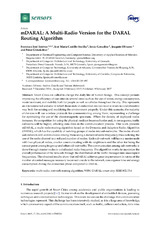mDARAL: A Multi-Radio Version for the DARAL Routing Algorithm
Autor
Estévez, Francisco José
Castillo Secilla, José María
González, Jesús
Olivares Bueno, Joaquín
Glösekötter, Peter
Editor
MDPIFecha
2017Materia
Multi-radioNetwork routing algorithm
WSN
DARAL
Smart city
IEEE 802.15.4
METS:
Mostrar el registro METSPREMIS:
Mostrar el registro PREMISMetadatos
Mostrar el registro completo del ítemResumen
Smart Cities are called to change the daily life of human beings. This concept permits
improving the efficiency of our cities in several areas such as the use of water, energy consumption,
waste treatment, and mobility both for people as well as vehicles throughout the city. This represents
an interconnected scenario in which thousands of embedded devices need to work in a collaborative
way both for sensing and modifying the environment properly. Under this scenario, the majority
of devices will use wireless protocols for communicating among them, representing a challenge
for optimizing the use of the electromagnetic spectrum. When the density of deployed nodes
increases, the competition for using the physical medium becomes harder and, in consequence, traffic
collisions will be higher, affecting data-rates in the communication process. This work presents
mDARAL, a multi-radio routing algorithm based on the Dynamic and Adaptive Radio Algorithm
(DARAL), which has the capability of isolating groups of nodes into sub-networks. The nodes of each
sub-network will communicate among them using a dedicated radio frequency, thus isolating the
use of the radio channel to a reduced number of nodes. Each sub-network will have a master node
with two physical radios, one for communicating with its neighbours and the other for being the
contact point among its group and other sub-networks. The communication among sub-networks is
done through master nodes in a dedicated radio frequency. The algorithm works to maximize the
overall performance of the network through the distribution of the traffic messages into unoccupied
frequencies. The obtained results show that mDARAL achieves great improvement in terms of the
number of control messages necessary to connect a node to the network, convergence time and energy
consumption during the connection phase compared to DARAL.

